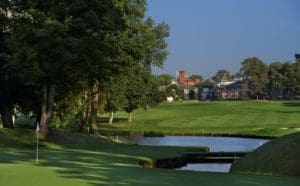Course Overview. The Brabazon Course at The Belfry is no stranger to the circuit with a number of events having been hosted here since the turn of the century, however prior to the 2020 ISPS Handa UK Championship won by Rasmus Hojgaard, 2008 was the last time that we saw the Peter Alliss and Dave Thomas design in competitive action at this level. 4 Ryder Cups have also been played around these parts, the most recent of which was team Europe’s win in 2002.
Parkland in style with water in play on half of the holes, the track measures 7,336 yards for its par of 72. 12 par-4s instead of the more typical 10 means that there are just 3 each of the par-3s and par-5s, however scoring on those longer holes at 538, 566 and 564 yards for the 3rd, 15th and 17th respectively is an important part of compiling a competitive score here.
Historically the fairways here have been narrow and the rough lush, however the Bent/Poa greens are of excellent quality giving a little respite to those who are less adept on and around the putting surfaces.

Tournament Stats. We’ve published some key statistics for this week’s event that will help to shape a view on players who might go well this week. Course stats include the various events that have been played here at The Belfry since 2000: Current Form | Course Form | First Round Leader Stats | Combined Stats.
Predictor Model. Our published Predictor Model is available here. As always you can build your own model using the variables available.
British Masters – Event Winners & Prices. 2022: Thorbjorn Olesen, 75/1; 2021: Richard Bland, 150/1; 2020: Renato Paratore, 50/1; 2019: Marcus Kinhult, 175/1; 2018: Eddie Pepperell, 30/1; 2017: Paul Dunne, 66/1; 2016: Alex Noren, 18/1; 2015: Matt Fitzpatrick, 33/1.
For a summary of winners’ odds on the European Tour for the past 10 years click here.
Course Winners. 2022: Thorbjorn Olesen, -10; 2021: Richard Bland, -13; 2020: Rasmus Hojgaard, -14; 2008: Gonzalo Fdez-Castano, -12; 2007: Lee Westwood, -15; 2006: Johan Edfors, -11; 2003: Paul Casey, -11; 2002: Angel Cabrera, -10; 2001, Henrik Stenson, -13; 2000: Jose Maria Olazabal, -13.
Weather Forecast. The latest weather forecast for the area is here.
Despite the odd thunderstorm, England’s weather has been fairly warm and dry for the recent past and save for a deluge prior to this week’s event, I’d expect the course to play reasonably firm and fast. Sunshine and light showers is the summary for the 4 days, with winds around 10-15 mph and temperatures reaching 70 Fahrenheit in the afternoons.
Tournament Trends & Key Factors.
Analysing the final stats of the three winners here at The Belfry in recent years gives us a little more insight into the skill-sets required:
- 2022, Thorbjorn Olesen (-10). 293 yards (17th), 38.3% fairways (67th), 57.0% greens in regulation (60th), 74.2% scrambling (4th), 1.67 putts per GIR (7th).
- 2021, Richard Bland (-13). 272 yards (52nd), 78.3% fairways (1st), 82.0% greens in regulation (2nd), 92.3% scrambling (1st), 1.78 putts per GIR (48th).
- 2020, Rasmus Hojgaard (-14). 304 yards (9th), 48.3% fairways (40th), 75% greens in regulation (6th), 55.6% scrambling (36th), 1.65 putts per GIR (1st).
Looking at the list of players who’ve succeeded around the Brabazon course here at The Belfry historically, it’s fair to say that generally better Total Driving and Ball-Striking has been the key to success. Of course there’s always an exception to the rule, and last year’s winner Thorbjorn Olesen is just that as his long game was poor in comparison but he managed to navigate to victory courtesy of his short game.
The greens here are generally easy to read and favour those players who might otherwise struggle on the putting surfaces, and again that’s reinforced when you see a list of names including Lee Westwood, Paul Casey and Henrik Stenson all having won here.
Strokes Gained: From a Strokes Gained perspective, the only consistent stat across all three renewals has been SG Approach with each of the winners ranking inside the top 10 on that account on the week:
- 2022: Thorbjorn Olesen: T: 64th; A: 9th; T2G: 31st; ATG: 31st; P: 2nd
- 2021: Richard Bland: T: 18th; A: 2nd; T2G: 1st; ATG: 37th; P: 55th
- 2020: Rasmus Hojgaard: T: 11th; A: 4th; T2G: 2nd; ATG: 38th; P: 20th
Aside from our winners, Justin Walters (2022 – 3rd), Mikko Korhonen (2021 – 3rd) and Benjamin Hebert (2020 – 3rd) each topped the SG Approach stats in their contending performances, so if there’s one stat to focus on this week then perhaps that’s it.
Key: T: SG Off the Tee; A; SG Approach; T2G: SG Tee to Green; ATG: SG Around the Green; P: SG Putting.
Incoming Form: Since the British Masters was re-established in 2015, the four winners prior to Marcus Kinhult – Eddie Pepperell, Paul Dunne, Alex Noren and Matt Fitzpatrick – had each shown some decent enough form in the weeks prior to their victory. Marcus Kinhult was far more difficult to find as he’d missed each of his previous 4 cuts, shooting 80 on his previous competitive round before opening with a 65 at Hillside and hardly looking back.
Eddie Pepperell had recorded 5 top-10 finishes in his previous 8 starts, 2 of which were runner-up finishes at the Scottish Open and Portugal Masters. Paul Dunne had produced two top-15 finishes in his previous three strokeplay events and after a shaky 74 to start on his most recent start in Holland, nobody in the field bettered his final 3-round total. For Noren this was the third of four 2016 victories and he was clearly in exceptional form overall, whereas for Fitzpatrick his win at Woburn marked his maiden success on the European Tour, however with four top-3 finishes in his previous 11 events he was clearly knocking very loudly on the door.
2020 winner Renato Paratore secured his second European Tour title at Close House off the back of a 15th place finish in Austria a fortnight before, which was his only start since lockdown had eased. The Italian sat 2nd at the halfway point at Diamond Country Club and had also been prominent in Saudi and Abu Dhabi in strong fields earlier in the year.
Richard Bland’s fairytale win in 2021, on the 478th time of asking as a professional, wasn’t completely out of the blue either as he’d finished runner-up at Leopard Creek the previous November and had recorded a top-10 finish in Gran Canaria as recently as 3 weeks prior.
Finally, last year’s winner Thorbjorn Olesen broke a 4-year drought when he fended off Sebastian Soderberg courtesy of some late putting heroics, however there had been signs that he was finding his game once again, recording a top 10 finish in Dubai in the late autumn before finishing 12th in Qatar where only a 3rd round 76 stopped him from seriously contending:
- 2022, Thorbjorn Olesen: MC/MC/20/41/8/42/35/MC/MC/12/23/33
- 2021, Richard Bland: 16/7/2/40/35/MC/52/MC/MC/8/MC/27
- 2020, Renato Paratore: 48/40/21/36/19/2/21/MC/27/74/47/15
- 2019, Marcus Kinhult: 22/30/71/22/20/MC/MC/18/MC/MC/MC/MC
- 2018, Eddie Pepperell: 43/51/DQ/MC/2/6/59/9/56/6/2/44
- 2017, Paul Dunne: 33/30/MC/MC/13/54/26/MC/9/14/70/14
- 2016, Alex Noren: MC/43/12/MC/8/1/46/49/2/1/34/11
- 2015, Matt Fitzpatrick: MC/3/MC/MC/77/2/17/44/3/30/3/MC
As an additional angle, we can also look at Rasmus Hojgaard’s win here at The Belfry at the 2020 UK Championship:
- 2020, Rasmus Hojgaard: 13/49/1/MC/MC/MC/MC/6/MC/2/6/3
The young Dane was a fairly obvious winner with incoming form of 2/6/3 over his past 3 starts and justified his 14/1 quotes in the end via a play-off.
Course Form:
Aside from Angel Cabrera, our course winners here had patchy history at best at The Belfry prior to lifting their respective trophies:
- 2022: Thorbjorn Olesen: 17/57
- 2021: Richard Bland: 46/31/MC/MC/19
- 2020: Rasmus Hojgaard: Debut
- 2008: Gonzalo Fdez Castano: 14/57
- 2007: Lee Westwood: 54/57/MC/27/MC
- 2006: Johan Edfors: Debut
- 2003: Paul Casey: 12/MC
- 2002: Angel Cabrera: 9/2
- 2001, Henrik Stenson: Debut
- 2000: Jose Maria Olazabal: Debut
For me, the Belfry is a good test of golf and scoring isn’t likely to get out of control, despite a fairly quiet weather forecast. Historically straightforward greens of excellent quality will encourage birdies though to those who can keep the ball in play, and overall I’d favour those who can gain most of their strokes from tee-to-green and with their approach play, as opposed to on the putting surfaces themselves.
![]() Betfred British Masters – Featured Bookmaker:
Betfred British Masters – Featured Bookmaker:


